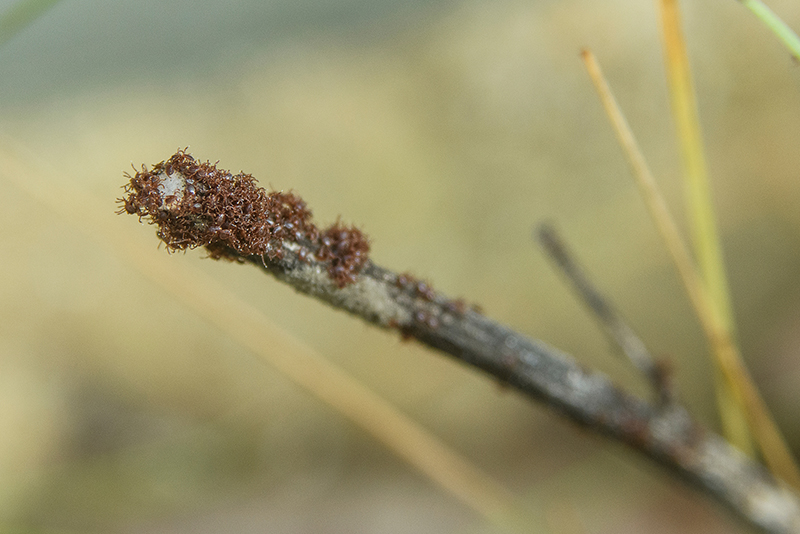Cheryl Sullivan was in the woods one warm October day, flicking yet another tick from her leg, “which felt like the tenth of the day,” she says.
Lyme-disease bearing deer ticks like the ones climbing on Sullivan, a Ph.D. student in UVM’s Entomology Research Lab, were certainly causing problems for humans, she remembers thinking. But a different species – the winter tick – was an even worse scourge for one of the northern woods most iconic species, the moose, for whom the parasite was an existential threat. A 2018 study published in the Canadian Journal of Zoology found that winter ticks, also known as moose ticks, were the primary cause of an unprecedented 70 percent death rate among moose calves in northern New England over a three-year period.
“I was thinking about the work that we did at the lab, and it’s like, gosh, I wonder if granular fungus would work on moose ticks,” she says, referring to the insect-killing fungi in granular formulation her colleagues had used to effectively control pests like the pear thrips, which attacks maple trees.
Two years later, more than 30,000 moose tick larvae have taken up residence at the lab, and Sullivan and her advisors, entomologists Bruce Parker and Margaret Skinner, have demonstrated that natural bio-pesticide formulations containing fungi like Metarhizium anisopliae have the potential to derail the moose tick epidemic.
In the lab, the fungus, depending on dose and application method, kills 37 to 100 percent of the larvae it comes in contact with.
Horror movie
No tick species inspires much human affection, but the winter tick’s habits are especially gruesome. Unlike the deer tick, which attaches itself to three progressively larger hosts over a two-year cycle, the winter tick limits itself to one host –a large ungulate like a moose, elk or sometimes a cow or horse – and lives for just one year.
In the spring, winter tick females drop off their host, lay eggs and die. The larvae hatch in the summer, clump together in groups of several thousand and lie dormant at the soil surface.
In fall the larval clusters seem to borrow a scene from a horror movie.
To quest for a host, they shimmy up vegetation en masse, seen above. When one comes into their vicinity, which the larvae can both see and sense via chemicals like CO2 or the heat and vibrations they emanate, they climb on top of one another to form a bloodthirsty strand. When the top tick reaches the host, those below swing on board.
“It’s kind of like follow the leader,” Sullivan says.
That coordinated group behavior, multiplied many times over, is why dead moose are discovered covered with an average of 47,000 ticks, making them anemic and vulnerable to a host of threats, a condition calves are especially prone to.
Climate change is a key driver of the moose tick plague. Shorter, warmer winters make it more likely that adult moose ticks will land on earth and leaves when they drop off their hosts rather than snow and ice, which kill the parasites before they can lay eggs. And longer falls extend the questing period.
Returning the favor
If the winter tick is a ruthless killer, the remedy Sullivan, Parker and Skinner have in mind returns the favor and then some.
The Metarhizium anisopliae fungus, which has many different strains that occur naturally in the soil, is a natural enemy of the tick, which it kills by penetrating its cuticle or outer shell.
That occurs in two ways, Parker says. “One is a mechanical pressure that the fungus exerts. The other is by emitting chemicals that help dissolve” the outer layer. Once inside, more chemicals are emitted by the fungus that “kill or completely engulf the inner portion of the tick.”
While the approach is promising in the lab, more work needs to be done before the team is ready to say it will work in the field.
“There are a lot of dimensions to that,” Sullivan says. A key one is finding the optimal habitat for both moose and the fungi and then determining exactly how and at what rate to apply the granular formulation.
If and when that happens, the winter tick larva’s habits could make it especially vulnerable. The fungi inhabit the same mix of soil and leaves that larvae find attractive, both thrive in warm, humid conditions, and the larvae’s long dormancy during the summer gives the fungi ample opportunity to find and neutralize clusters.
While naturally occurring fungi are probably killing tick larvae to a limited degree, Sullivan and her colleagues envision one day spreading granular Metarhizium anisopliae throughout a localized area of prime moose habitat, once they’ve worked out the application and dosage challenges.
“If we can give nature a hand by boosting the fungal components that are already in the ecosystem,” she says, “that could be a difference-maker.”
The research project has received support from the U.S .Fish & Wildlife Service; Wildlife & Sport Fish Restoration Program, Wildlife Restoration Grants, U.S. Geological Survey and the American Wildlife Conservation Foundation. It is part of an ongoing partnership between the USGS Vermont Cooperative Fish and Wildlife Research Unit, the UVM Wildlife and Fisheries Biology Program, and Vermont Fish and Wildlife Department.
Source: UVM News

